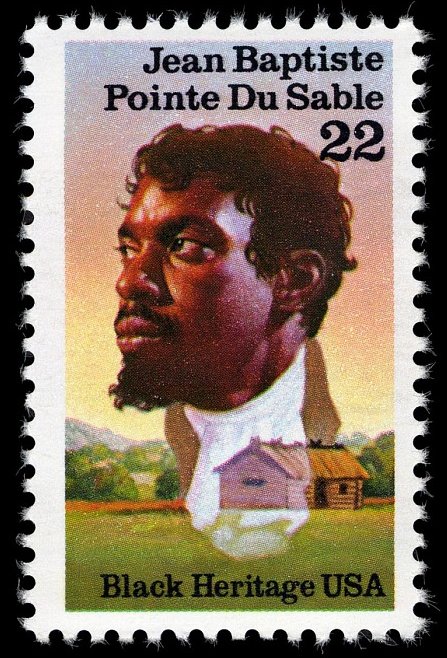Jean Baptiste Pointe DuSable
Linda Zabors
Jean Baptiste Pointe DuSable was the pioneer credited as being the first non-native resident of what is now Chicago. He developed his property on the north bank of the Chicago River near the shores of Lake Michigan (ca. 1779)
In 1673 Father Jacques Marquette and Louis Joliet explored this region and noted it’s good location as a trade route through the Great Lakes to the Mississippi River.
DuSable was born (ca. 1745) in what was the French Carribean colony, now know as Haiti, to a woman of African descent and a French mariner. He was educated in France and came to the United States around the early 1770s to make his fortune. He entered the New World through the port at New Orleans and made his way up the Mississippi River to Illinois. It was there he married his wife Kitihawa, a Potowatomi woman. They built a house and raised their two children in the area which is now Chicago.
At the time, fur trading was big business. In 1627 The Company of New France was established in what is now Montreal, Canada, which setup operations to source furs from the new world.
During the American Revolution he was arrested by the British, and for a while imprisoned at Fort Mackinac in Michigan before returning to Chicago. DuSable was a neutral party and had been involved in peace negotiations with native tribes.
In addition to his native French, DuSable spoke English, Spanish, and several tribal languages, all of which served him well in his trading business. DuSable was a very successful. In 1800 he sold his property and moved down the Mississippi, ultimately to Missouri, where he spent his last days. In 1968 a historic marker was placed at his gravesite.
The DuSable cabin was featured in an exhibit at the 1933 World Fair in Chicago “Century of Progress,” where he was recognized as Chicago’s first permanent resident. He was officially recognized by the City as Chicago’s founder on March 1, 2006.
b. ca. 1745 in St. Marc, San Dominigue (Haiti)
d. August 28, 1818 in St. Charles, Missouri. Approx age 73.
Several sites and organizations in Chicago are named for DuSable
Pioneer Court
This is the location where Dusable built the house where he lived with his wife and children. He developed his estate which included his trading business, barns, garden, orchard, stables, smokehouse, dairy, bakehouse, and where he employed others to work on his property.
He lived here for about two decades. His wife, Kitihawa (Catherine), was a member of the Potowatami Native American tribe. They were married in a tribal ceremony and later in a Catholic ceremony in Illinois in 1778. They had two children, a son, Jean, and a daughter, Suzanne. His granddaughter Eulalie Pelletier was born in 1796.
In 1789 he bought an additional 400 acres of property; this area was now part of the United States.
DuSable sold his property in 1800 and moved downstate. His property was later owned and occupied by John Kinzie (for whom Kinzie Street is named), the Kinzie family lived there until they fled during the Fort Dearborn Massacre of 1812. When Kinzie sold the property in 1834 it extended from the Lake to approximately Chicago Avenue at State Street.
Honorary Dusable Bridge
Michigan Avenue crossing the Chicago River to Wacker Drive
Approved: 2010
Ward: 42
Alderman:
Neighborhood: Magnificent Mile
The bridge crossing the Chicago River at Michigan Avenue opened in 1924. It was the world’s first double-deck traffic moveable bridge.
Photo: Honorary Chicago / Linda Zabors 2020. Honorary DuSable Bridge (raised) over Chicago River
Map image: OpenStreetMap.org Contributors 2022, annotated: Honorary Chicago
DuSable Harbor
DuSable Harbor is located just south of the mouth of the Chicago River and the Coast Guard Headquarters at the Chicago Lakefront. DuSable Harbor is managed by the Chicago Park District.
DuSable Founders Way
The river esplanade on the north bank of the Chicago River between the Honorary Dusable Bridge and DuSable Lake Shore Drive is called DuSable Founders Way.
DuSable Park
DuSable Park, a parcel of lakefront land near the Ogden Slip on the north bank of the Chicago River near Lake Point Tower, was dedicated in 1987 by Mayor Harold Washington. The 2005 redevelopment of the park was stalled after the a nearby real estate financing fell through and when the site was determined to be in need of environmental remediation. Efforts are underway to develop this park.
Jean Baptiste Pointe Dusable Lake Shore Drive
Rededicated in 2021
Lake Shore Drive dates back to the early days of Chicago history. It is a famous street which runs along the shores of Lake Michigan. It was renamed to honor DuSable, as Chicago’s first non-native resident, in 2021.
Dusable Museum
Founded in 1961 as the Ebony Museum of Negro History and Art, the museum was renamed in honor of Jean Baptiste Pointe DuSable.
Dusable High School
Built in 1935 as the New Wendell Philips High School, an expansion of the original school.
The following year, on April 25, 1936 the New Wendell Philips High School was renamed in honor of Jean Baptiste Point DuSable, as the founder of Chicago.
Many famous people attended this school, DuSable Hall of Fame. The building received Landmark Status in 2012.
DuSable Postage Stamp
In 1987 a 22-cent US postage stamp was issued in honor of Jean Baptist Pointe DuSable.
Source
WTTW
Encyclopedia of Chicago
Dusable Heritage Foundation
DuSable Museum
DuSable High School
Chicago Tribune. Kogan, R: https://www.chicagotribune.com/entertainment/ct-ent-kitihawa-drive-chicago-kogan-1204-20191203-mtwyzk24rrcjpfumlgczcgswsu-story.html
Wikipedia: Kitihawa Pointe Du Sable https://en.wikipedia.org/wiki/Kitihawa_Point_du_Sable
The Root. Henry Louis Gates, Jr. 2013
https://kids.kiddle.co/Jean_Baptiste_Point_Du_Sable_Homesite



